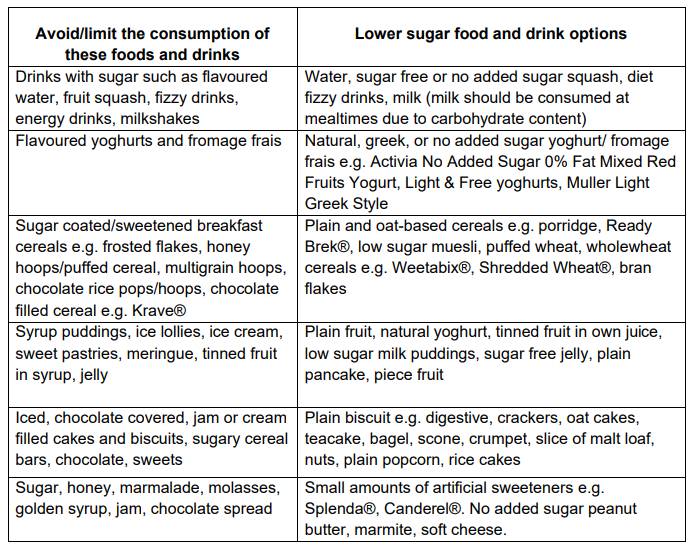What to Feed a Child With Diabetes Type One
Dietary Advice for Children Newly Diagnosed with Type 1 Diabetes
Please note, this page is printable by selecting the normal print options on your computer.
First Line information for children and their families
One of the first questions many families and children have when they have been diagnosed with Type 1 diabetes is, "what can I eat?" or "what can my child eat?" A child with Type 1 diabetes should follow a healthy, balanced diet which is recommended for the whole family. It is important that children with diabetes eat three regular meals a day to meet their nutritional requirements for growth and development, and to help control their blood glucose levels. A healthy diet is also important to help protect against other conditions such as high cholesterol. Carbohydrate is the only nutrient which directly affects blood glucose levels. It is important to include carbohydrate-rich foods in the diet as they are the body's main energy source. Carbohydrate can be found in sugary foods (e.g. cakes, sweets, fizzy drinks), starchy foods (e.g. bread, potatoes, rice, pasta) and foods containing natural sugars (e.g. fruit, fruit juice, milk, yoghurt). Sugary foods will cause blood glucose levels to rise quickly and should therefore be avoided, apart from in the treatment of low blood glucose levels (hypoglycaemia).
A child is likely to have been very thirsty prior to diagnosis. It is important to avoid sugary drinks to quench thirst as this will result in blood glucose levels rising quickly (see next page for drink
suggestions). Children may also feel hungrier than usual following diagnosis, but this normally settles down once the insulin starts working. If your child has an increased appetite, try to offer
larger portions of healthy meals rather than frequent snacks.
The following is recommended for children with Type 1 diabetes:
1. Include starchy carbohydrates at each meal such as bread, pasta, potatoes, yams, plantains, rice, chapatti or cereals. Starchy foods should make up a third of the food we eat each day. Try to pick wholegrain starchy foods where possible and avoid those with added sugar, salt and saturated fat.
2. Include lean protein at each meal such as meat, fish, beans, pulses, nuts and eggs. Aim for at least 2 portions of fish per week, one of which should be oily e.g. salmon, mackerel and sardines.
3. Have 3 portions of dairy products per day (children aged 5-18yrs) such as milk, yoghurt or cheese. One portion = 125g pot yoghurt, match-box size (30g) hard cheese, 200ml milk.
4. Avoid foods and drinks high in sugar. Foods that contain small amounts of sugar can be eaten in moderate amounts with a meal. You may find it useful to use the list below for lower sugar alternatives.
5. Aim for at least 5 portions of fruit and vegetables per day. They can be fresh, frozen, tinned, dried or juiced. Fruit juices and smoothies should be limited to a maximum 150ml per day and should only be consumed at mealtimes (except for when using for treatment for a low blood sugar) due to the high sugar content. Fruit and vegetables should make up a third of the food we eat each day.
6. Choose healthier unsaturated fats such as olive, rapeseed, sunflower oils and spreads and eat in small amounts.
7. If snacks are eaten between meals these should contain no more than 10g of carbohydrate in total between each Novorapid insulin injection. Your dietitian will provide you with a list of suitable snacks.

Avoid foods labelled as 'diabetic' or 'suitable for diabetics'. These products are often expensive and can contain sweeteners like sorbitol or xylitol, which can have a laxative effect. It would be better to have a small amount of the standard product at a mealtime. Over the next few weeks you will be taught by the dietitian how to carbohydrate count, which involves calculating how much carbohydrate meals and snacks contain. You will be given lots of resources to help with this. Carbohydrate counting enables tighter blood sugar control and will give your child greater flexibility with timings of when they would like to eat.
There are many myths about foods that children with diabetes should and shouldn't eat – if you are not sure about particular foods or drinks please ask your dietitian or diabetes team for advice.
Useful resources:
– Diabetes UK www.diabetes.org.uk
– Videos to support children and
young people with Type 1 Diabetes www.digibete.org/
– Recipes ides on Diabetes UK www.diabetes.org.uk/Guide-to-diabetes/Recipes/
– Healthy eating tips www.nhs.uk/change4life-beta/food-facts
– Carbs&Cals app www.carbsandcals.com/app/app
Source: https://www.mkuh.nhs.uk/patient-information-leaflet/dietary-advice-for-children-newly-diagnosed-with-type-1-diabetes
0 Response to "What to Feed a Child With Diabetes Type One"
Post a Comment